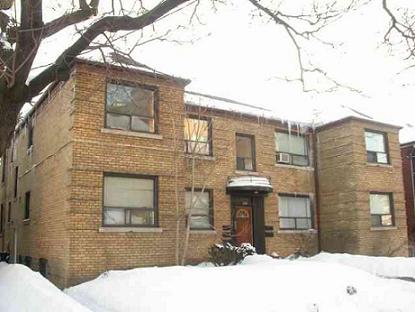I drove over to my friend Ryan’s place the other day, and I saw a “FOR SALE” sign on the lawn of the Four-Plex where he’s been renting for the last three years.
The sign didn’t look out of place, since this will be the third time the property has turned over in the last three years!
Every investor seems to have the same mentality: “I think I can make this property work!”

I liken the situation with this investment property to a scene from Arrested Development that I saw the other day.
Lindsay and Tobias, a married couple with severe marital difficulties, are discussing their options.
Tobias, is a failed therapist and Lindsay is a rich socialite.
Tobias: “You know Lindsay, as a therapist I have advised a number of couples to explore an open relationship where the couple remains emotionally committed, but free to explore extra-marital encounters.”
Lindsay: “Well, did it ever work for those people?”
Tobias: “No, it never does. I mean, these people somehow delude themselves into thinking it might…”
(pause)
Tobias: “But it just might work….for US!”
Classic!
Man, I love that show, but I digress…
With respect to this investment property on Bathurst, I’ve personally witnessed the property turn over twice while my friend has been renting there, and now it is for sale for a third time.
I can’t figure out why people keep “trying their luck.”
I first rented a 3-bedroom apartment in this building to my friend Ryan in October of 2005. The price was an obscenely low $1,200 per month.
Although the price seemed low at the time, would you believe me if I told you that now, in March of 2009, he is still paying $1,200 per month?
This points to the most blatant error by all three owners of this property since Ryan has been renting there: financial mismanagement.
Surely at some point it might have occurred to one of the three owners that they could bring in $1500 – $1700 for this three bedroom apartment, no?
Let’s trace the history of this property for the last twenty years, shall we?
The owner of the property when Ryan first moved in had purchased the property in February, 1989 for $955,000. Owner #1 held this property until April, 2006, and sold it to Owner #2 for $825,000.
A lot transpired in the real estate market between 1989 and 2006, and what better way to illustrate it than this graph:
So Owner #1 purchased the property at the absolute peak of the Toronto real estate market, and then her world quickly imploded…
On paper, she took a $130,000 loss on the property while selling to Owner #2, but don’t forget that she had been collecting rent for nearly seventeen years, so surely she came out on top in the end. The accountants can point to the massive capital loss she could use to offset her income for years after 2006.
Owner #2 took over the property in April, 2006, and they didn’t even bother to raise Ryan’s rent.
While there are very generous laws in place under the Landlord & Tenant Act to protect tenants, since Ryan was on a month-to-month lease, all the owners had to do was give Ryan 60 days notice and then advertise the property for lease at a new price to a new tenant.
This $1,200 per month, 3-bedroom unit should have been bringing in $1,600 per month, and it makes me question how much more each of the other three units could have been renting for each month.
Ryan had countless issues with Owner #2, from the leak in the roof, to the malfunctioning of the coin-operated washer/dryer, to their unauthorized taking-over of his storage space in the garage.
After a little less than two years, Owner #2 sold the property to Owner #3 in April, 2008 for $987,000.
I asked Ryan, “What did Owner #2 do to improve the property in the two years she owned it?”
Ryan’s response: “Absolutely nothing.”
Call it “timing the market” if you want, but Owner #2 made a capital-gain of $162,000 on this property after running it for less than two years. Not a bad little investment!
Now fast forward only eleven months, and Owner #3 has listed the property for sale at a whopping $1,299,000.
The property is only assessed by MPAC at $942,250, which is less than they paid for it!
Again, I asked Ryan, “What did Owner #3 do to improve the property in the eleven months they owned it?”
He said they added a 1-bedroom apartment to the basement, did a little landscaping last summer, and “tried” to fix a crack in the foundation.
Soooo…..where are the $312,000 in improvements?
And hasn’t the market fallen in the last eleven months?
Owner #3 is looking for a 31.6% return on their investment over eleven months, or 34.5% year-over-year.
Yeah……I also enjoy sniffing glue for fun…
You know that old expression, “You can’t drink two beers from one bottle?” It seems to me that Owner #3 figures that since Owner #2 held the property for two years and made a rather large capital gain, then he too can sell the property for an even bigger gain!
But it’s not going to happen.
The market has fallen, and they’ll be lucky to get the $987,000 that they paid last year, plus maybe a small premium for the “improvements.”
The crazy part is, we haven’t even considered the income that this property brings in, which is how all investment properties are evaluated and priced!
But why bother looking at the capitalization rates of a property when the damn thing has been offered for sale by three owners in three years?
It’s pretty obvious that everybody who touches this thing believe they have the Midas-touch when there’s something about the building that is poisonous.
As for Ryan, well, he just recently rented out the third bedroom for $475 per month, so his all-in cost has been reduced to about $250 per month!
This is what he told me last night over a beer while he laughed at my $2,000 per month all-in cost…
Damn you, Ryan!
































N. J.
at 12:53 pm
A capital loss can only be used to offset a capital gain, not ‘other income’ as you say.